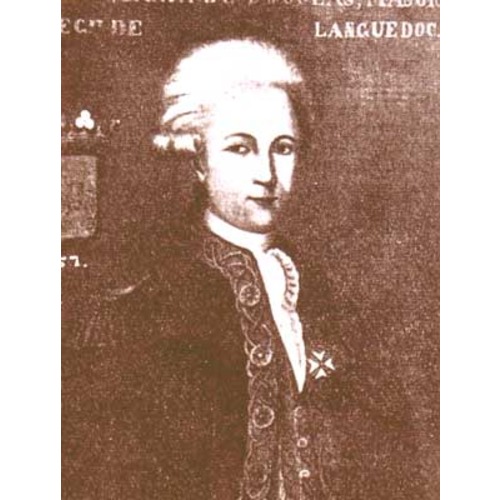
Source: Link
DOUGLAS, FRANÇOIS-PROSPER, Chevalier de DOUGLAS, officer in the French regular troops; b. 21 Feb. 1725 at Montréal, in Bugey (dept of Ain), France, son of Charles Douglas, Comte de Douglas, syndic of the nobility of Bugey and officer, and Marie-Anne de Lilia; d. 26 April 1781 at Nantua, France.
In keeping with family tradition, François-Prosper Douglas took up a military career. In 1743 he was a second lieutenant in the Régiment du Languedoc, the next year he was promoted lieutenant, and he subsequently took part in several European campaigns. In 1746 he was made captain of a company in the second battalion of his regiment, and he still held this command when he arrived in Canada in 1755 with the French troops under Dieskau*.
Douglas’s military record seems undistinguished, although he participated in several actions during the Seven Years’ War. He was at Lac Saint-Sacrement (Lake George) in 1755, at the capture of Oswego (Chouaguen) in 1756, and at Fort Carillon (Ticonderoga, N.Y.) in 1758. According to the casualty list he was wounded “very lightly” in the last battle. In his letters to his family he did not mention the injury, complaining only of the hardships he had endured since coming to Canada, where soldiers had to be ready, for action whenever the weather permitted. The wound may nevertheless have been the reason for his being made a knight of the order of Saint-Louis on 20 Oct. 1758.
During the siege of Quebec the next year, Douglas was second in command of a party led by Jean-Daniel Dumas which attempted to dislodge the British from Pointe-Lévy (Lauzon) on the night of 12–13 July. The force consisted of Indians, regulars, militia, townspeople, and some seminarians whom a wag christened “the Royal Syntax.” It became separated in the dark; its members mistook one another for the British, fired, and retreated precipitately without having attacked the enemy. It is not known whether Douglas was at all at fault in this fiasco. He appears to have been in charge of the Samos battery, which fired on the British fleet during the landing at Anse au Foulon on 13 September but which was abandoned after being attacked by Wolfe*’s men. A ministerial note in the muster-roll of captains says that he “served well. A good captain, without other talent.” His record in Canada would seem to bear out that judgement.
Douglas was more remarkable for having been one of the fewer than 20 regular officers to marry Canadian women. Montcalm*, who generally disapproved on the grounds that the officers were marrying below their social class and thereby jeopardizing their careers, approved of Douglas’s match. Charlotte de La Corne, whom Douglas married on 13 April 1757, was of noble descent through her father Louis, known as La Corne l’ainé, and her mother Élisabeth de Ramezay. Montcalm described her as “a woman of quality, with very good family connections in the colony and a suitable fortune.” As a nobleman Douglas would in turn have been considered a highly desirable match in Canada.
He returned to France after the conquest, taking his wife and family with him. Two sons had been born in Canada, Louis-Archambaud, later made a knight of the order of Saint-Louis and imprisoned in 1794 during the Terror, and Charles-Luc. Another child was born in Touraine, where Douglas stayed some time after his arrival in France. In 1763 he embarked for Corsica; he remained there for six years, during which he took part in several military operations. He then retired and returned to France in 1769. Subsequently he wished to come back to Canada to settle on the seigneury of Terrebonne, which he had inherited from his father-in-law, but he was unable to carry out the scheme and he died in 1781 at Nantua, near his birthplace.
AMA, SHA, A1, 3457, no. 60; Xb, carton 77 (copies at PAC). AN, Col., C11A, 120; F3, 15, pp.172, 275 (copies at PAC). ANQ-M, État civil, Catholiques, Notre-Dame de Montréal, 13 avril 1757. Coll. des manuscrits de Lévis (Casgrain), III, 131. Doreil, “Lettres” (A. Roy), ANQ Rapport, 1944–45, 3–32. “Journal du siège de Québec” (Æ. Fauteux), ANQ Rapport, 1920–21, 170, 229. Æ. Fauteux, Les chevaliers de Saint-Louis, 229. La Chesnaye-Desbois et Badier, Dict. de la noblesse (1863–76), VI, 989. Tanguay, Dictionnaire. Stanley, New France, 224. Pierre Gauthier, “De Montréal (en Bugey) à Montréal (au Canada),” RHAF, III (1949–50), 30–44. “Officiers du régiment de Languedoc,” BRH, LI (1945), 285. P.-G. Roy, “Les officiers de Montcalm mariés au Canada,” BRH, L (1944), 260, 280–81.
Cite This Article
Susan W. Henderson, “DOUGLAS, FRANÇOIS-PROSPER, Chevalier de DOUGLAS,” in Dictionary of Canadian Biography, vol. 4, University of Toronto/Université Laval, 2003–, accessed January 12, 2026, https://www.biographi.ca/en/bio/douglas_francois_prosper_4E.html.
The citation above shows the format for footnotes and endnotes according to the Chicago manual of style (16th edition). Information to be used in other citation formats:
| Permalink: | https://www.biographi.ca/en/bio/douglas_francois_prosper_4E.html |
| Author of Article: | Susan W. Henderson |
| Title of Article: | DOUGLAS, FRANÇOIS-PROSPER, Chevalier de DOUGLAS |
| Publication Name: | Dictionary of Canadian Biography, vol. 4 |
| Publisher: | University of Toronto/Université Laval |
| Year of publication: | 1979 |
| Year of revision: | 1979 |
| Access Date: | January 12, 2026 |



